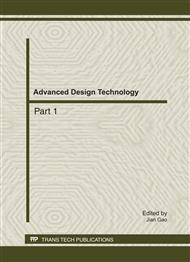p.1865
p.1875
p.1880
p.1885
p.1889
p.1893
p.1900
p.1910
p.1914
Stiffness and Nature Vibration Analyses of Linear Guideway Type
Abstract:
This study investigated the solution of the rigidity and structural vibration for system of linear guideway type based on ANSYS workbench. By comparing the results derived from the simulation of the model and the corresponding theoretical results, the validity of the theoretical solution can be verified. The analysis includes the system rigidity and the natural vibration frequency in the direction of vertical slider (Vertical), rolling (Rolling) and swing (Pitching), the structural vibration frequency for system of linear guideway type is carried out, the model is built according the true dimensions, what is more, the rollers are not necessary replaced by springs, because there is not so much difficulties by using ANSYS workbench and more accurate results can be obtained in this way. Two different types of simulation are carried out, and the simulation results show that different geometric sizes of slider, which mean different numbers of rollers, will change the resonance frequencies and mode shapes, and more rollers can enhance the stiffness of the LGT model, then reduce the possibility of resonance happening.
Info:
Periodical:
Pages:
1889-1892
Citation:
Online since:
August 2011
Authors:
Price:
Сopyright:
© 2011 Trans Tech Publications Ltd. All Rights Reserved
Share:
Citation:


